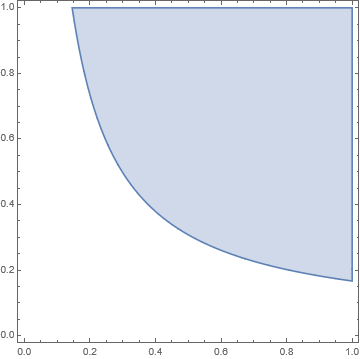The solution of fun[x,y]>0 leads to the following output
fun[x_, y_] = (1/16)*(1 - 6*x*y + (-1 + x)*x*y)*(1 + x*(-1 + 6*y) +
x*(-1 + x + y - x*y))*(-1 + 2*x -
x^2 + (x + (-1 + x)*x*(-1 + y) - 6*x*y)*(6*x*y + (x - x^2)*y));
Reduce[fun[x, y] > 0 && 0 < x < 1 && 0 < y < 1, y]
$$\color{blue}{\left(\frac{1}{2} \left(7-3 \sqrt{5}\right)<x\leq 2-\sqrt{2}\land -\frac{1}{x^2-7 x}<y<1\right) }\lor \color{red}{ \left(2-\sqrt{2}<x<1 \land \left(\frac{x-2}{2 (x-7)}-\frac{1}{2} \sqrt{\frac{x^4-4 x^3+8 x-4}{(x-7)^2 x^2}}<y<\frac{1}{2} \sqrt{\frac{x^4-4 x^3+8 x-4}{(x-7)^2 x^2}}+\frac{x-2}{2 (x-7)}\lor -\frac{1}{x^2-7 x}<y<1\right)\right)}$$
The way I understand this is:
- blue and red are two solutions
- when $x$ lies in range $\frac{1}{2} \left(7-3 \sqrt{5}\right)<x\leq 2-\sqrt{2}$, $y$ can take values in the range $\color{green}{-\frac{1}{x^2-7 x}<y<1}$
- when $x$ lies in range $2-\sqrt{2}<x<1$, $y$ can take values in the range $\frac{x-2}{2 (x-7)}-\frac{1}{2} \sqrt{\frac{x^4-4 x^3+8 x-4}{(x-7)^2 x^2}}<y<\frac{1}{2} \sqrt{\frac{x^4-4 x^3+8 x-4}{(x-7)^2 x^2}}+\frac{x-2}{2 (x-7)}$ $\textbf{or}$ $\color{green}{-\frac{1}{x^2-7 x}<y<1}$
Is Mathematica telling me that $y$ exists in range $-\frac{1}{x^2-7 x}<y<1$ for two different ranges of $x$?
Doesn't 2 and 3 imply $-\frac{1}{x^2-7 x}<y<1$ for $\frac{1}{2} \left(7-3 \sqrt{5}\right)<x\leq1$?





